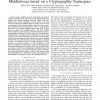Free Online Productivity Tools
i2Speak
i2Symbol
i2OCR
iTex2Img
iWeb2Print
iWeb2Shot
i2Type
iPdf2Split
iPdf2Merge
i2Bopomofo
i2Arabic
i2Style
i2Image
i2PDF
iLatex2Rtf
Sci2ools
ICC
2009
IEEE
2009
IEEE
End-Host Authentication and Authorization for Middleboxes Based on a Cryptographic Namespace
—Today, middleboxes such as firewalls and network address translators have advanced beyond simple packet forwarding and address mapping. They also inspect and filter traffic, detect network intrusion, control access to network resources, and enforce different levels of quality of service. The cornerstones for these security-related network services are endhost authentication and authorization. Using a cryptographic namespace for end-hosts simplifies these tasks since it gives them an explicit and verifiable identity. The Host Identity Protocol (HIP) is a key-exchange protocol that introduces such a cryptographic namespace for secure end-to-end communication. Although HIP was designed with middleboxes in mind, these cannot securely use its namespace because the on-path identity verification is susceptible to replay attacks. Moreover, the binding between HIP as an authentication protocol and IPsec as payload transport is insufficient because on-path middleboxes cannot securely m...
| Added | 21 May 2010 |
| Updated | 21 May 2010 |
| Type | Conference |
| Year | 2009 |
| Where | ICC |
| Authors | Tobias Heer, René Hummen, Miika Komu, Stefan Götz, Klaus Wehrle |
Comments (0)

